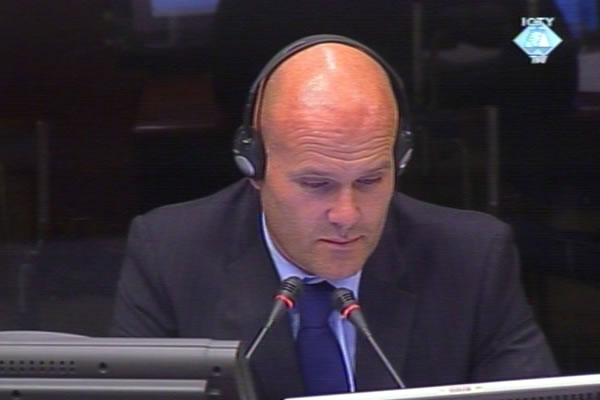Home
KARADZIC: DARKNESS FELL AT 4 PM IN SARAJEVO
In an effort to challenge the expert report on sniper incidents in Sarajevo drafted by prosecution expert, Dutch captain Patrick van der Weijden, Radovan Karadzic claimed that in January, it is already dark in Sarajevo at 4 p.m.
 Patrick Van der Weijden, witness at the Radovan Karadzic trial
Patrick Van der Weijden, witness at the Radovan Karadzic trial Although the Trial Chamber initially allowed Radovan Karadzic to take an additional half hour to cross-examine Dutch expert witness Patrick van der Weijden, today he took almost the entire hearing to complete it. The Chamber allowed him to do it when it was told the prosecution would not be calling any other experts to testify about the sniper incidents in Sarajevo.
Over the last three days, Karadzic took ten hours to cross-examine the Dutch captain. He challenged Van der Weijden’s findings for all sixteen sniper incidents listed in the indictment against him. As he claimed, the prosecution had ‘misled’ the witness because he was given inaccurate and incomplete information about the incidents he was to analyze, including the information about the locations from which fire was opened on the civilians in Sarajevo.
Karadzic challenged Van de Weijden’s analysis of an incident in which Nafa Taric and her eight-year-old daughter Elma were hit with a single bulled in Ivana Krndelja Street on 3 September 1993, fired from Ozrenska Street. According to the accused, the bullet may have been fired from the territory controlled by the BH Army.
As for the wounding of Sanela Dzevlan in Dobrinja on 6 January 1994, the Dutch expert found that she had most likely been hit by a round fired from the Serb-controlled territory in Dobrinja 4. Karadzic contended the time of the day was not favorable for sniper action. According to him, at 4 p.m. it’s ‘deep dusk’ in the Sarajevo valley. The witness agreed with Karadzic that the time of day was important for snipers, but added that in this case, he never claimed that the bullet was fired from a sniper rifle. It may well have been fired from another weapon, perhaps even a machine gun.
Karadzic then moved on to an incident in which Sanela Muratovic was injured on 26 June 1994. According to the Dutch expert, the shot that hit her had most probably been fired from the Serb positions in the Institute for the Blind in Nedzarici. Karadzic insisted that the front line was close to the site, and there were also several BH Army soldiers there, who helped the wounded girl. As he said, the area where the victim was could be considered a ‘military zone’. He also claimed that ‘throughout the war, old age people’ lived in the nearby old pensioners’ home.
Karadzic concluded his cross-examination of the Dutch captain by asking him about an incident in which Munira Zametica was killed as she drew water from the Dobrinja river, on 11 July 1993. According to Karadzic, Zametica was killed in an exchange of fire between the warring factions; she was not shot by a sniper targeting civilians who had come to fetch water. He asked the witness why the people who had come to fetch water before her had not been hit. “I guess they were lucky,’ the witness replied.
In a brief re-examination, the prosecutor brought up a map showing that the tram tracks in front of the Holiday Inn hotel were not straight during the war as Karadzic claimed, but that there was indeed a double bend which forced the trams to slow down and made them more vulnerable to sniper fire.
The trial of the former Republika Srpska president continues tomorrow with the evidence of another witness who will support the prosecution allegation that there was an artillery and sniper terror campaign against Sarajevo and its residents.
Linked Reports
- Case : Karadzic
- 2010-09-28 KARADZIC: TRAM TRACKS AIN'T WHAT THEY USED TO BE
- 2010-09-27 CIVILIANS TARGETED BY SNIPERS
- 2010-09-16 WITNESS: BH ARMY DIDN’T USE HEAVY ARTILLERY
- 2010-09-30 KARADZIC: GENERAL CHAOS AND HIS AIDE FEAR
- 2010-10-01 INTERCEPTS REMAIN IN EVIDENCE AGAINST KARADZIC
- 2010-10-05 HOW KARADZIC’S ‘GOOD DEED’ TURNED INTO EVIDENCE FOR PROSECUTION
